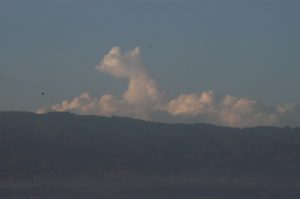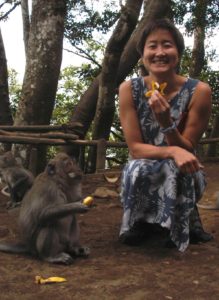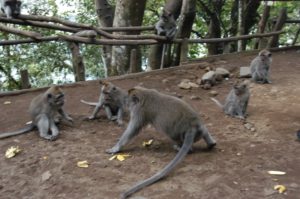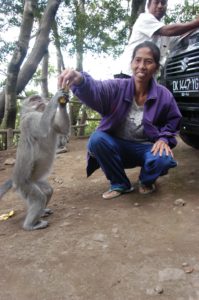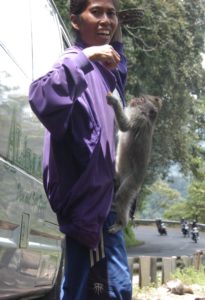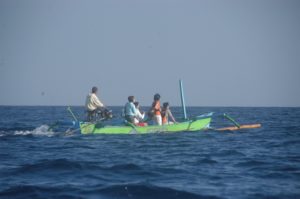
Day 4 of my trip to Indonesia (Sept 2009)
Dolphin Encounter
Today we went dolphin watching at Lovina beach in Bali; I give the trip mixed reviews. First, we had to ride out further than expected to get to deeper waters in hopes of seeing dolphins. This was actually okay because we enjoyed the ride and the scenery. But instead of seeing the horizon or having a postcard view of the coast we saw a brown haze. It was smog! From the cars, maybe from Java, and definitely from the boats, which are traditionally outriggers with ancient motors. Throughout the ride you could smell the fumes and hear the loud engines. Given that sound travels well under water, I can only imagine the effect on the fish. If I were a dolphin, I’d probably elect to avoid areas with boats and their noisy, polluting motors.
We did see a few dolphins, although not like the entire pod Asri’s sister saw on her last visit. Such things are not predictable. What I was really missing was information from the guide about the dolphins and their behavior. After the bird park experience from the day before, I wasn’t surprised that the guides didn’t know anything about the dolphins. They were really just boat drivers, and I guess most people are happy to look at animals without really learning anything about their lifestyle and habits. Seems like a huge missed opportunity to me, though.
On the way back we stop to peer over at the fish. At first I can’t see anything, but then the boat guide tell us they’ll come up if we toss food in. So I toss a bit of bread and sure enough tons of fish come teeming up to the top.
Overall it would have been nicer to make this experience more of an eco-adventure. That way if no dolphins are seen, it’s still a good learning experience. For that to happen, though, the guides need to learn quite a bit about dolphin social behavior, hunting, and communication.
Monkeys Everywhere
Later, on the way across the island, we stopped to observe a troop of crab-eating macaques by the side of the road. This troop is comprised of probably 5-10 families and spans several stops along the road. As I get out to take photos a local woman brings out a plate of bananas and says, “10,000 rupees.” She wants me to purchase bananas to feed the macaques. Now, in general, it’s not a good idea to feed wild animals, because pretty soon they’re taking the food from you and even biting to get it. Or, if they’re bears at Yosemite or another national park, they’re raiding your garbage can or breaking into your car. The driver tells us that these macaques by the side of the road are not yet very aggressive to humans. The ones in the Monkey Forests where many visitors go regularly grab food from people and grab sunglasses and other accessories because they know that people will need to use food to get their stolen items back.
At first I refuse to purchase bananas, but then I realize that no matter what, these monkeys are going to be trained by humans to grab food away eventually. So I get some bananas and take a photo for my Dumbass file. Me feeding a wild animal from a known aggressive species-looks harmless enough, but it’s not. I did make sure I gave the banana to the highest ranking female only when she was sitting rather than accidentally rewarding her for grabbing for it or jumping. Other visitors let the monkeys jump up and grab the food from them, and the local woman let one of the baby macaques jump on her.
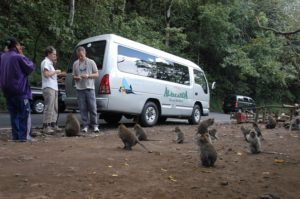
What she probably doesn’t know is that a macaque bite can innoculate humans with herpes virus which leads to fatal brain disease. And she probably doesn’t know how aggressive the macaque social system is. Macaques live in a female-dominated hierarchy. The females have a rank order and everyone in their family retains that rank relative to other families. So if you’re born into the family of a low ranking female, you’re out of luck. What’s more, they have what’s called a despotic social system in that they routinely maintain their rank by picking on others who are below them. In a research setting, if a high ranking monkey is removed for an extended period of time, serious fighting occurs as the rank order is upset.
Aggression is apparent with these macaques. The dominant female takes all of the food and none of the others around her can get a banana because she attacks them.
Note that like with the Bali dogs, these monkeys provide a glimpse into how domestication occurs. Domestication is a process occurring over many generations in which a population of animals becomes more adapted to living with humans. This process involves genetic changes. In contrast, tameness is a process that occurs within an animal’s lifetime by which animals become less fearful of humans. A tame animal is defined as one that does not flee from humans. As animals become tame, the distance to which a human can approach before the animal moves away (flight distance) decreases.
This troop of monkeys has become less fearful of humans, so they are tamer than monkeys living far away from humans. Because they are less fearful, they can make good use of food sources close to humans-such as trash, human food, and food that humans feed them. Over many generations as the most tame breed and reproduce well, the genetic make-up of the population can change so that the monkeys are easier to tame and more tame early on than populations in the jungle.


